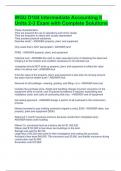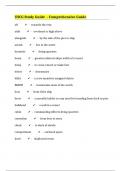WGU D104 Intermediate Accounting II Units 2-3 Exam with Complete Solutions
These characteristics:
They are acquired for use in operations and not for resale.
They are long-term in nature and usually depreciated
They possess physical substance.
Describe what? - ANSWER-property, plant, and equipment
Only asset that is NOT depreciated - ANSWER-land
PP&E - ANSWER-property, plant, and equipment
historical cost - ANSWER-the cash or cash equivalent price of obtaining the asset and bringing it to the location and condition necessary for its intended use
companies should NOT write up property, plant, and equipment to reflect fair value when it is above cost - ANSWER-true
if the fair value of the property, plant, and equipment is less than its carrying amount, the asset may be written down - ANSWER-true
Removal of old buildings—clearing, grading, and filling—is a - ANSWER-land cost
includes the purchase price, freight and handling charges incurred, insurance on the equipment while in transit, cost of special foundations if required, assembling and installation costs, and costs of conducting trial runs. - ANSWER-cost of equipment
full-costing approach - ANSWER-Assign a portion of all overhead to the construction process
Money borrowed to pay building contractor (signed a note), $300 - ANSWER-other, non
property, plant and equipment ($300)
Refund of 1-month insurance premium because construction completed early - ANSWER-listed under building
Wilson Co. purchased land as a factory site for $1,350,000.
Wilson paid $120,000 to tear down two buildings on the land.
Salvage was sold for $8,100.
Legal fees of $5,220 were paid for title investigation and making the purchase.
Architect's fees were $46,800. Title insurance cost $3,600, and liability insurance during
construction cost $3,900.
Excavation cost $15,660. The contractor was paid $4,200,000.
An assessment made by the city for pavement was $9,600. - ANSWER-$1,480,320
Correct. Removal of old buildings—clearing, grading, and filling—is a land cost because
this activity is necessary to get the land in condition for its intended purpose. Architect Fees, liability insurance, and excavation are included in the cost of the building. Therefore, the cost of the land is calculated as: $1,350,000 + $120,000 - $8,100 + $5,220 + $3,600 + $9,600 = $1,480,320.
GAAP requires you to capitalize ___ costs incurred during construction - ANSWER-
actual
the amount capitalized is the lesser of actual interest cost incurred during the period or avoidable interest
or The amount of interest to capitalize is limited to the lower of actual interest cost incurred
during the period or avoidable interest - ANSWER-true
AAE - ANSWER-Average accumulated expenditures-the total expenditures during the period, therefore the debt could have been avoided
AAE can be calculated with - ANSWER-weighted or simple average
capitalized interest= - ANSWER-weighted-average accumulated expenditures x% of interest
companies should record property, plant, and equipment at ____ value of what they give up or at _____ value of the asset received, whichever is more clearly evident. - ANSWER-the fair value
To properly reflect cost, companies account for assets purchased on long-term credit contracts at the ______ value of the consideration exchanged between the contracting parties at the date of the transaction. - ANSWER-present
prudent cost concept - ANSWER-if for some reason a company ignorantly paid too much for an asset originally, it is theoretically preferable to charge a loss immediately
Burchell Company purchased land and a building for a lump sum cost of $420,000. The land has a fair market value of $160,000 and the building has a fair market value of $320,000.
What is the cost assigned to the land? - ANSWER-$140,000
When a purchase is made at a lump-sum price, the company allocates the cost based on the relative fair values of the assets. The land has a fair value of $160,000/($160,000
+ $320,000) or 33.333333%. The cost allocated to the land is $420,000 x 33.3333333%
or $140,000.





